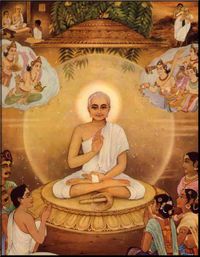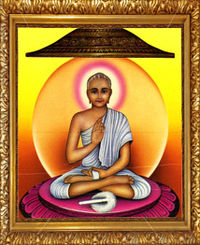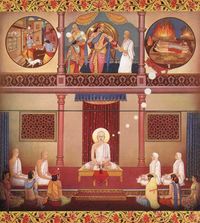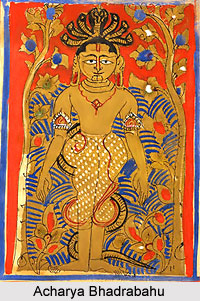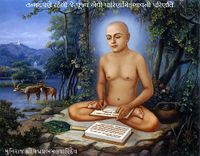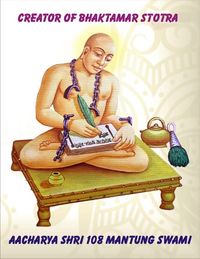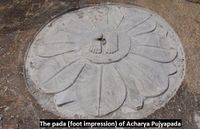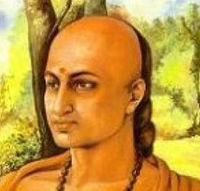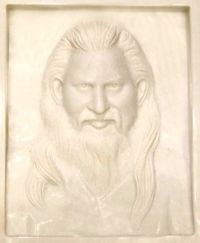Jain Brahmans
Jain Brāhmans are the Brahmins or Brāhmans who follow Jainism. They are known by different names according to the regions they are in India. These titles are Arcaka, Indra, Pandit, Purohit, Upadhye, or simply Jain Brāhman.[1]
Brāhmans have played a major role in the diffusion of Jainism throughout India from the royal ministers like Chanakya and Bhadrabahu to monarchs themselves like King Mrigesvarman of the Kadamba Dynasty and King Bhadra Bhatt of the Harikela Dynasty. Several scholarly works greatly revered by the Jain community even today was composed by Brāhmans such as those of Jinasena Suri and Siddhasena Divakara. Even Jain Brāhman laypeople contributed in spreading Jainism. For example, a revival of Jainism is identified in the 5th century BCE when a Brāhman couple (Nathasarman and Rami) donated land grants and made offerings at Vatagohai (Goalbhita) for the maintenance of a Jain vihara founded by Acharya Guhanandin.[2]
A Ganga Dynasty epigraph at Sravana Belgola reads of Gopanandi, the head of the Desiyagana Mula Sangha and Kunda Kundanvaya sangh:
| The celebrated Gopanandi accomplished what had been impossible for any one ; for he caused the Jina dharma which had for a long time been at standstill, to attain the prosperity and fame of the time of the Ganga kings.[3] |
There are also some ethnic groups that claim to descend from Jain Brāhmans. For example, the Kotila caste of Gujarat claim to descend from the firstborn son Kotila, of Trikam the Jain Brāhman (who married an Ahir woman.)[4]
Some Brāhmans declared that Jainism was the best religion for a Brāhman to follow. Their ideas of tolerance were well preached. Haribhadra Suri prayed, "As Brahma or Visnu or Siva or Jina— we salute all."
There are also Brāhmans historically that were not Jain but offered their aid and solidarity to Jain preachers. For example, when in the 12th year as a monk, Mahavira took shelter in the cottage of Brāhman Svatidatta with a view to pass monsoon months there, and him and Mahavira often entered into philosophical conversations with Mahavira and believed Mahavira was a great monk.[5] There was also Bahula who gave hospitality at his settlement in Kollaga near Sravasti to Mahavira.[6]
It was also historically common for Jains to participate in many ceremonies of mainstream Hindu societies. The priest of the temple there was Challapilla, a Jain Brāhman from the Sittannavasal area in the south, Ponnamaravati Sima, as it was then called. The Sambhavanatha idol at Sankarpur, Burdwan, WB, was found in the Ajaya riverbed by the forefathers of the current Brahman custodians of the idol.[7]
Communities[edit]
It is even stated in the Vikramarjumasijayam, that Bhima, the father of two great Jain scholars Adikavi Pampa and Jinavallabha, who was a wise man embraced Jainism as he considered it as the best dharma.[8]
The Sevaks of Rajasthan are of Sakaldwipiya (Sakhadwipi Brāhman) descent and originally converted because of the promise of their king. The story goes that the monarch was bitten by a venomous snake and a Jain saint said he would cure the king upon the condition that all his subjects become Jain, to which the ruler agreed. The students living in the Osia gurukul partook in this feast and hence although they didn't know the terms of the feast, they honored it and converted.[9]
Jain Brāhmans exist in most regions where there are Jain communities. There is a Brāhman community in southern Karnataka which is traditional follower of Jainism and is known as Jain Brāhman. They have a hostel for students in Mysore, known as Jain Brāhman Hostel.[1] This community is different from the Jain priests in Jain temples. There is an event in Indian history wherein the Vaji Brāhmans of the Vengi region (in modern-day Andhra Pradesh) converted to Jainism. Padmaksi Temple of Hanumakonda is managed by Brahmans, and Padmaksi is worshiped as Durga.
Modern priestly duties[edit]
Jinasena admits the utility of a Jain Brāhman or ksullaka for the performance of kriyas.[10]
There are two types of Jain Brāhman priests - the Bhojak and the flower priests. The duties of the Bhojak are to act as a Jain temple pujari or worshiper. In one account their origin is said to be of Audichya Brāhmans, in another account as Maga Brāhmans that were hired to be pujaris in a temple by King Kumarapala, and in the third account as Maga Brāhmans brought by King Jayasimha Siddharaja from Mandal (in Saurashtra.)[11] In Ahmedabad, Gujarat there are epigraphs of Jain sites which write of Brahmana Gacchhas.[12] Also in Gujarat, there was a shrine of Sri Ajitnath Bhagwan in the Bhamati (a cloistered corridor for a covered walk around the inner sanctum of the temple) of Sri Mahavir Swami (of Brahman Gachchha or Brahman Order) installed in Vikram year 1242.[13][2] The Jain Brāhmans priests dress like normal Brāhmans priests.[14] While in Shvetambar temples, the lay Jains will enter the inner sanctum of the temple to make offerings onto the murti or icon, in southern Digambara temples the priests make the offerings on behalf of the lay Jains.[15]
In Kohlapur, Maharashtra amongst the Jain community the sixteen samskaras or sacraments that Jain initiate into, are nearly the same as the sixteen Brāhman samskaras. Except that the Jain priest's ritual texts are not Vedic the rites do not differ from those performed by Brahmans.[16] Even their birth ceremonies are the same.
Notable scholars and sages[edit]
The influence brought by Brāhmans or tactics borrowed from them into Jainism is described by scholars. For example, some Jain teachers like Vardhamanadeva and Munichandra partook in royal administration and even directing military, and so it is said that Jains adopted traditional Brāhman tactics in dynastic governments.[17] Certainly the scriptural contributions of Brāhmans are well known, and before Indrabhuti Gautama there were none for Jainism. The organization of writing as well was borrowed from the existing Brāhman system. Some scholars like Dr. Vide Hoernle, even believe that the model of the Brāhman ascetic was the prototype from the beginning of Indian history for all ascetics to borrow important practices and institutions from though this is disputed. However, it is also believed by some scholars such as Oldenberg that related ascetic orders such as the Buddhists derived the disciplic successive tradition from Brāhmans.[18]
There are also Jains who by legend are believed to have been Brāhman but scriptural evidence isn't available to confirm their backgrounds. For example, Kundakunda Acharya (or Elachariya) the Tamil sage is believed to be the son of Brāhman father and weaver mother.[19] Another is poet Tolkappiyar, author of the Tolkappiyam, who is called a "padimaiyon" or observer of Jain "padimai" (vow).[20] Also because Mantunga Acharya mentions mainstream Hindu demigods' names in his poems so often, Professor Hiralal Kapadia says that it is possible the poet Mantunga was a Brāhman.[21]
Mahavira's eleven Ganadharas[edit]
Mahavira's eleven ganadharas or "Masters of Jainism" were very important for preaching and spreading the message of Jainism, and attracting new followers. Mahavira's first converts was Indrabhuti who bought into the group 10 other Brāhmans he converted.[22] Mahavira's nine ganadhars managed nine classes of Jain followers. All but sages Mandita and Maurya managed the classes. Sudharma is honored as one of the most important Jains in history. The author of the Kalpa-Sutra says that all the Jains are successors of Sudharma and that all the sakhas or orders of priests (including the ones today) originate from his historical leadership. Out of Mahavira and the other Ganadharas, he was the last survivor of that group of leaders.
The nine ganadharas of Mahavira were as follows:
| Name | Ethnicity | Birthplace and time period | Parentage | Accomplishments |
|---|---|---|---|---|
| Achalabhrata | Magadhi-Prakrit | |||
| Agnibhuti | Magadhi-Prakrit | Govara-gama | Vasubhuti and Prthvi | |
| Akampita | Mathili | Mithila | Vasu and Nanda | |
| Indrabhuti | Magadhi-Prakrit | Gorbara | Vasubhuti and Prthvi | It is believed he composed the twelve Angas, twelve Puvvas, twelve Upangas, ten Payannas, six Cheda-sutras, four Mula-sutras, and two Culika-sutras. |
| Mandita | Magadhi-Prakrit | Mauryagama | Dhanadeva and Vijayadevi | |
| Metarya | Magadhi-Prakrit | Vatsa | Dhammila and Bhaddita | |
| Maurya | Magadhi-Prakrit | Dhanadeva and Vijayadevi | ||
| Prabhasa | Magadhi-Prakrit | Rajagriha | Bala and Atibhadra | |
| Sudharma | Magadhi-Prakrit | Kulluka-gama | Dhanamitra and Dhammilla | |
| Vyakta | Magadhi-Prakrit | Kulluka-gama | Dhanamitra and Dhammilla (or Varuni) | |
| Vayubhuti | Magadhi-Prakrit | Vasubhuti and Prthvi |
More important persons[edit]
| Name | Ethnicity | Birthplace and time period | Sect | Position | Composition(s) | Significance |
|---|---|---|---|---|---|---|
| Akalanka Bhatt Deva | Kannada | Savanaballugole (near Cinraipatam, 8th century CE)[23] | Digambara | Svarupa-Sambodhana | He was the son of Jinadasa (an Arhaddvija) and Jinamati. His brother was Nihkalanka. Their guru was Buddhist Bhagavad Dasa. He was said to be the pioneer in the field of Jain logic. Upon discovery by Akalanka and his brother's Buddhist guru Bhagavad that they were Jain, he ordered their deaths. Nihkalanka sacrificed himself so that Akalanka could escape. He competed in debate against both Brāhmans Kumarila Bhatt of Mimamsa and Dignaga of Mahayana Buddhism. | |
| Balachandra[24] | Gujarati | Modheraka (in Gujarat) | He is believed to have written on Jain leaders ganadharas but this work has yet to be found. | |||
| Bhadrabahu | Bengali | He was the chief spiritual mentor of Chandragupta Maurya. | ||||
| Bhadrabahu Swami | (Born 94 years after Mahavira's attaining of Nirvana.[25]) | Acharang Sutra, Krutang, Avashyak, Dash Vaikalik, Uttaradhyayan, Dasha Shrut Skandh, Kalp, Vyavahr, Surya Pragnapti, Rishibhashit, and Vasudev Charit | He had great knowledge of 14 Poorvas, which he passed on to Acharya Sthul Bhadra and thus, the legacy of great literature could survive. Acharya Bhadrabahu has a record of entering into Yoga Meditation of Mahapran Yoga. For twelve years continuously Acharya Bhadrabahu moved all over India and made profound development of Jainism and its spreading all over. He is respectfully remembered as first and last "shrut kevali" (most versatile knowledgeable personality) both in Svetambara and Digambara sects. His Vasudev Charit, which contains 125,000 words. | |||
| Bhadrakirto (Bappa Bhatti) | He converted King Ama, son and successor or Yaso Varman in Kanyakubya to Jainism. | |||||
| Bilhana | Kashmiri | (11th century CE) | Anahillapataka, Karnasundari-natika, Parshvanathastaka | |||
| Brahmasiva[26] | Kannada | (12th century CE) | Samaya-parikshe | He was a Kannada Saiva at first but became a Jain. | ||
| Buddhisagara Suri (also Sripati) |
Gujarati | (11th century CE) | Svetambara (Nagpuriya Tapagaccha) | Pancagranthi-Vyakarana or Sabdalaksma (Sanskrit)[27] | He started (or restarted) the worship of Ghantakarna in Jainism in Mahudi (northern Gujarat) by installing a shrine there.[28] | |
| Chala Pille[29] | Tamil | Bhulokanatha or Sittanvasal (near Pudakottai, Tamil Nadu) | Yati (Priest) | He migrated from Tamil Nadu to Andhra for securing royal patronage of Jainism from competitors.[30] He was priest of the Brahma-Jinalaya Temple of Parshvanatha. | ||
| Chamunda Raya[31] | Marathi | Digambara | The image erected by Chamunda Raya, "is not only the most ancient in date and considerably the highest of the three, but from its striking position on the top of the very steep hill and the consequently greater difficulty involved in its execution, is by far the most interesting."[32] He earned several titles such as Samara-Parashurama.[33] Some of these titles were because of his moral behavior, and others because of his military skills. | |||
| Chandra Sen[34] | Maharastri-Prakrit | Bhinmal (4th century BCE) | He established the city of Chandravati wherein most residents were Jain, and several of them rich. The wealthy denizens of the city spent money for construction of Jain temples and other institutions. | |||
| Dhanapala[35] | Avanti-Prakrit | Ujjain (10th century CE) | Digambara | Bhavissayatta Kaha (Apabhramsa), Paiyalacchi (Prakrit Jaina-Maharastri), Rsabhapancasika (Prakrit Jaina-Maharastri.) | He was a renowned stotra writer. He was converted by his brother Shobana from Buddhism.[36] He is best known for his hymns named Rsabhapancasika, written in Prakrit (Jaina-Maharastri.)[37] Bhavissayatta Kaha is another work in the Apabhramsa language. He also wrote Paiyalacchi in Prakrit. | |
| Dhangiri | Sauraseni-Prakrit | Tumbhivan (or Tumbavanagrâma in Malwa, 5th century CE) | Svetambara[38] | He was a reputedly wealthy Brāhman, in the town of Tumbhivan, lost his interest in wealth and decided to take Diksha, after hearing the sermons of the Jain Acharya Sinhgiri. | ||
| Durgasvamin | Dingal-Prakrit | (10th century CE) | Svetambara | He was a wealthy man but left for living as ascetic. Maharaja Indravarman donated one hala of land to him in Siddarthaka-grama of Varaha- Varttini (district.)[39] Also, he was a teacher of the reputed Siddharsi in Marwar around the 10th century.[40] He attained Nirvana in Bhillamala. | ||
| Gunabhadra | Digambara | Disciple of Jinasena. | ||||
| Haribhadra Suri (also Virahunka) |
Sauraseni-Prakrit | Chittor, Rajasthan (705 CE to 775 CE) | Svetambara | Compendium of Six Philosophies (Sad Darsana sammucayas) and The Essence of Religion (Dharmabindu.) | He was a Rajasthani Brāhman, very well noted in the 8th-century Jain community. He had taken a personal vow to be the disciple of any person whose work proved beyond his understanding.He wrote in Sanskrit and Prakrit on ethics, ascetism, yoga, logic, and rituals. He also composed works on satire and astrology as well as novels and canonical commentaries. With his Compendium of Six Philosophies (Sad Darsana sammucayas). He created a novel style of logic in an era noted for the equality of its philosophical debates. The Essence of Religion (Dharmabindu) is a major contribution to the religious life of the laity. He was the royal priest of King Jitari. He converted the Porwals (Pragwata) of Shrimala (modern Bhillamala) to Jainism. He assumed the title of "Virahunka" when his nephews were defeated in debate by a Buddhist. | |
| Harihara[41] | Bengali | (13th century CE) | He was a Bengali poet patronized by Vaghela King Vastupala. | |||
| Irivabedehga Satyasraya | Kannada | Yapaniya | He was the son and successor of Kesava Bhatt, and he continued to extend patronage to Jainism.[42] | |||
| Jayaghosa | Magadhi-Prakrit | He is mentioned in the Uttaradhyayana Sutra as a famous Jain monk that undertook Jain vows and subdued all his senses. | ||||
| Jinavallabha Suri[43] | Telugu | Vengipura, Andhra Pradesh (11th century CE) | Digambara | Pindavisuddhi | ||
| Jinesvara Suri (also Sivadasa or Sridhara) |
Maharastri-Prakrit | (11th century) | Svetambara (Nagpuriya Tapagaccha) | Gaharayanakosa | ||
| Kadua Sah | Dingal-Prakrit | (1438 CE) | Svetambara (Ancala Gaccha) | He was a Nagar Brāhman and subsequently became a lay member of the Ancala Gaccha, a subsect of the Svetambara. | ||
| Kapila | Magadhi-Prakrit | Kaushambi | He was a great scholar and is remember for having sprinkled powder on the Parshvanatha's icon in Ujjain. | |||
| Kapila Muni | Svetambara | Adhyaya VIII (section of Mula-Sutra) | He was [according to Shanti Suri] was the son of Kashyapa and Yasha, and he wrote the Adhyaya VIII section of Mula-Sutra scripture, which forms an independent discourse titled "Kaviliyam".[44] | |||
| Karmegha Pulavar | Tamil | Kongumandalam (17th century CE) | Kongumandala Satakam. | |||
| Kakuda Katyayana[45] | Magadhi-Prakrit | (6th century BCE) | Mahavira refers to his philosophy of pluralism or Anekavada. | |||
| Kankamar Muni | (11th century) | Karakanduchariu (Apabhramsha) | ||||
| Kautilya | He befriended Chandragupta Maurya and aided him in politics to become emperor of the Mauryan Dynasty, and successor to the Nandas. He is considered one of the greatest politicians of Indian history. | |||||
| Kesava Bhatt | Kannada | Yapaniya | At Betole we see a record telling that he belonged to the Mulasangha of the Yapaniya gachcha.[46] His son was his successor. | |||
| Keshiraja | Kannada | Permadi | Shabdamanidarpana | He wrote the non-spiritual text Shabdamanidarpana of grammar. | ||
| Khandaga Kaccayana[47] | (6th century BCE) | He was an apostle of Parshva's doctrine in Mahavira's period. | ||||
| Meghachandra Bhattar Siddhantadeva | Tamil | (12th century CE) | He is stated to have belonged to the anvaya of Kundakunda Acharya, Mesha Pashanagacchha and Kanurgana from an inscription of Jadcherla in Mahabubnagar district from 12th century CE. | |||
| Nagamiah[48] (also Nagamayya) |
Kannada | Punganur | ||||
| Nannul Pavananti[49] | Tamil | Nannul | Tradition goes that after he wrote the grammatical text Nannul, the then ruler Ciyakahkan requested Pavananti to write a simple Tamil grammar so as to enable even ordinary people to understand it. | |||
| Pundarik | (19th century CE) | |||||
| Pushpadanta[50] | Digambara | Mahapurana (Apabhramsa) | Puspadanta was a Digambara and patronized by Bharata of the Rashtrakuta court. After he embraced Jainism, he became the leading Apabhramsha of the period, and was patronized by Krishna III's ministers Bharata and Nanna.[51] | |||
| Nagavarma I | Kannada | Vengipura, Andhra Pradesh (11th century CE) | Digambara | Chandombudhi | He was the army general of Chalukya King Jagadekamalla. | |
| Nagavarma II[52] | Kannada | Vengipura, Andhra Pradesh (11th century CE) | Digambara | An inscription declares he was "born of a heavenly coral tree arising in the ocean of Brahmans." | ||
| Pampa[53] | Kannada | Vengipura, Andhra Pradesh (11th century CE) | Digambara | Vatukosa | ||
| Pampaiah[54] | Rona | |||||
| Ponna[55] | Kannada | Vengipura, Andhra Pradesh (11th century CE) | Digambara | Shanti Purana | His Shanti Purana was on the 16th Tirthankara Shantinatha. | |
| Pujyapada Bhatt (also Acharya Devanandi, Jinendra Buddhi)[56] |
Kannada | Kolangala (510 CE to 600 CE) | Digambara | Manual of All Reals (Sarvartha Siddhi), and a commentary on the Tattvartha Sutra, Jainendra Vyaakaran, System of Meditation (Samadhi Tantra), Eulogy of Accomplishments (Siddhapriya Stotra), Ten-fold Devotions (Dasa Bhakti), and the Sermons on Desirable Practices (Istopadesa).[57] Pancavasutka (commentary on Jainendra Vyaakaran.) | He was a Kannada Brāhman ascetic. He was a poet, philosopher, grammarian and expert of indigenous medicines. He has been credited with many accomplishments, which aided in the promotion of Jainism in the south. | |
| Raghava Pandaviya (also Shrutakirti) |
Telugu | Virincipuram (near Nellore) | Digambara | Dvisamdhana-kavya (Sanskrit) | His Dvisamdhana-kavya poems were from the Mahabharata and Ramayana. | |
| Ranna[58] | Ajita Purana, Gadayuddha | His Ajita Purana was on the 2nd Tirthankara Ajitanatha. | ||||
| Sajjambhava[59] | Rajgriha (4th century CE) | Dasavaikalika Sutra[60] | He was another born from Rajgriha and was elected the head of the Jain order by Prabhava. | |||
| Shobhanmuni | Gujarat (10th century CE) | Wrote Jinchatturvishatika. | ||||
| Siddhasena Divakara | Avanti (c. 500 CE to 610 CE) | Descent of Logic (Nyaayavtaar), the Logic of the Right Wisdom (Sanmati Sutra), Eulogy of Welfare (Kalyaana Mandir Stotra), and several hymns. | He was a Jain ascetic who founded the Jain system of logic, and was instrumental in the popularity of Jainism in eighteen kingdoms of central, southern and western India.[61] | |||
| Siddharshi | Srimala, Marwar (10th century CE) | Svetambara | Upamitibhavaprapaficakatha (Sanskrit) | |||
| Skandaka Katyayana | (6th century BCE) | He was a disciple of Mahavira. | ||||
| Soma[62] | Magadhi-Prakrit | He was one of the chief disciples of Tirthankara Parshva. | ||||
| Soma[63] | Gujarati | Kotindra, Saurashtra, Gujarat | He was well-versed in the Vedas and Agamas and performed the six prescribed rites. | |||
| Soma Bhatt | Telugu | Medak district inscription mentions him. | ||||
| Somesvara Suri[64] | Gujarati | Gujarat (13th century CE) | Kirtikaumudi, Prasasti | He was a royal patron of the Vaghela King Vastupala and composed the Kirtikaumudi and Prasasti, and several inscriptions of in Girnar and an inscription at the Mt. Abu temple of Neminatha.[65] | ||
| Sushil Kumar[66] | Hindi | Shakarpur, Haryana (1926-1994) | Svetambara (Sthanakavasi) | Acharya | Was an Acharya known better to Jains as "Guruji", was born a Vaidik in the Shakarpur village of the Haryana province. At the age of 15, he took Diksha (became a sanyassin) into the Sthanakvasi, a Svetambara sub-sect. He is believed to be the fulfillment of a prophecy. Brigu Samhita says, "In this era, Sushil Muni is a perfect master...he is briliant as the sun, as peaceful as the moon, as wise as the Buddha...every word he speaks becomes a mantra. He is the door to liberation..."[67] | |
| Sayambhava | Kotikapra, Pundravardhana (4th century BCE) | Dasavaikalika Sutra | He was a dasapurvi (leader) of the srutakevalins to which Bhadrabahu which eventually become leader after scholarly succession of a few other leaders. | |||
| Sahkaradasa[68] | He was the teacher of Paramara king and was converted by Abhayadeva Suri. | |||||
| Sayyambhava | Dasavaikalikasutra | He converted upon seeing an image of Shantinatha. He was an Acharya who lived at Griha. | ||||
| Skandhaka (a.k.a. Khandaka) | He was a wandering ascetic that was converted by Tirthankara Mahavira.[69] | |||||
| Vadiganga Bhatt (Munjaraya)[70] | Kannada | (10th century CE) | A grant was made to him by King Marasimha of the Western Ganga Dynasty. | |||
| Vidyananda | (8th century CE) | Digambara | Ashta Shahastri (Sanskrit), Aptapariksa | He compiled in the Sanskrit language, Ashta Shahastri with eight thousand verses. | ||
| Vishalaksha Pandita (also Yelendur Pandit) |
Telugu | He was minister of Chikka Devaraja of the Wodeyar Dynasty. | ||||
| Umasvati (also Umaswami) |
(2nd century CE) | Tattvartha Sutra or Tattvarthadigama Sutra | He was a composer who was so loved by Jains that he is considered by the Digambara sect to be a Digambara member and the Svetambara sect to be a Svetambara member. His Tattvartha Sutra is accepted as authoritative by all Jain traditions.[71] | |||
| Vag Bhatt | (5th century CE) | Neminirmana | ||||
| Vag Bhatt I | Vag Bhatt Alankara | |||||
| Vag Bhatt II | (12th century CE) | Chandanushasana, Risabha-deva-chahta |
Scriptural contributions[edit]
Before Indrabhuti the Jain Brāhman Ganadhara of Mahavira, there were no Jain scriptures. He is credited with writing several Jain sastras.
The Jain canons, both Digambara and Svetambara were organized based on the Vedic Brāhman literature. As Buddhists emulated the textual organization system of Vedic Brāhman scholars[72] so did the Jains. The scriptural division of sastras into Anga and Upanga categories for major Jain scriptures was brought by Umasvati. In about 800 CE Jinasena's Parsvabhyudaya poetic biography by him included also poet Kalidasa's Meghaduta.[73]
Sanskrit became a language to learn for many educated Jains. Because local Jain scriptures throughout India were in the vernacular languages, in order to spread their wisdom to the entire Jain community and educated Indians everywhere, they were translated into Sanskrit. For example, Muni Sarvanandin translated Lokavibhaga. With the Sanskrit writing education and emulation of scriptural organization from the mainstream Hindu scholars, Jainism became a very academic religion which debated intellectually.
Local languages too flourished with Jain Brāhmans. Pampa, Ponna and Ranna, popularly known as 'three jewels of Kannada literature' enriched Kannada literature.[74] Nannul Pavananti wrote the Tamil grammatical text Nannul. Legend says that after he wrote the Nannul, the then monarch Ciyakahkan requested Pavananti to write a simple Tamil grammar so as to enable even ordinary people to understand it. Pujyapada Bhatt was also a Kannada grammarian. Keshiraja was also a Kannada grammarian who composed the Shabdamanidarpana. The greatest poet of Apabhramsa is said to be Puspadanta who wrote his Mahapurana, Jasaharacariu, and Nayakumaracariu at Manyakheta under patronage of minister of Rashtrakuta King Krishna III.
The importance of Brāhmans was recognized, and the need to protect them is explicitly referred to in the Purananuru, Silappadikaram, and the Jivaka-chintamani.[75]
In kingdoms[edit]
Monarchs[edit]
- Kadamba Dynasty kings of Palasika were Jain Brāhmans who supported Jainism and gave land grants, and erected many temples. King Mrigesvarman of Palasika further went on to give grants to Yapaniyas, Nigranthas and Kurchakas. King Shivakoti had also adopted Jainism.
- Harikela Dynasty King Bhadra Bhatt, was grandfather of the Buddhist King Kantideva (Maharajadhiraja) of Harikela, and was a devotee of Jinendra.
Ministers and clerics[edit]
Tradition mentions that Rashtrakuta Dynasty's Krishna I appointed Jain Brāhmans as his negotiators in Calukyan dominions.[76] A copperplate grant from the Gupta period found in the vicinity of Somapura mentioned a Brāhman donating land to a Jain vihara at Vatagohali.
- Bhadrabahu was the guru of Chandragupta Maurya of the Magadhan Empire, who had converted the Magadan Emperor to Jainism. Titles he's called by are Bhagwan, Sramana Guru, Swami, and Yatindra.
- Buddhisagara Suri, was a teacher of Jainism to Akbar in the Mughal court, and was the son of Soma, and brother of Jinesvara Suri.[77]
- Jatha Simhanandi is believed to have been the guru that aided two brothers Daddiga and Madhava, whom founded the Ganga Dynasty.[78]
- Jinesena along with his teacher Virascna, is credited with converting Amoghavarsha, the Rastrakuta Dynasty king, to Jainism.
- Jinesvari Suri was a mendicant leader and founder of the Svetambara Murtipujaka Kharatara Gaccha. It is said that in a debate at the court of King Durlabha of Patan in Gujarat, in 1024 CE, he defeated Suracharya, a prominent temple monk who had argued that it was proper for mendicants to live permanently at temple complexes and to own property.[79]
- Kapalka, the minister of the Nanda Dynasty's king was born in Pataliputra, and the Nanda king desperately wanted Kapalka to become his minister due to Kapalka's powerful political skills.[80]
- Sri Silaguna Suri of Brahmana gaccha[81] was the guru Vanaraja of Gujarat's Cavada Dynasty.
- Vadighangala Bhatt was Rashtrakuta royal guru to Krishna III and upon his advice, Krishna III conquered surrounding regions
- Vasudeva, a Brāhman general in the army of Kamadeva in the Vijayaditya dynasty had built a temple dedicated to Lord Parshvanath.
Legends about Brāhman figures[edit]
Ambika Devi is also known commonly as Agnila and Kuṣmāṇḍinī amongst other names. As all Tirthankaras have a Yaksha guardian, she is the guardian of Neminatha, the 22nd Ford-Maker. She is a popular deity of worship in Jain temples and homes. In the unpublished scripture Ambika-devi-kapla of Subhacandra, "Om Kusmandini rakte rakta-mahisa-samradhe subhasubham kathaya jhvim svaha" is the mantra. Haribhadra Suri in his Lalitavistara refers to her as Vaiyavrttakara and a Sasanadevata. Her sons Siddha and Buddha are also known as Subhankara and Prabhankara. According to legends, after human life she was reborn in the Kohanda Vimana heaven, where she also became known as Kohandi.
In legends, Parsvanatha in his previous incarnation was Marubhuti.
There are stories about two non-ascetic Brāhman brothers born to Hutasana and Jalanasikha. They were Jalana who was straightforward, and Dahana who was deceitful. They were born reborn in Indra's internal assembly. Later Jalana achieved Nirvana because he was the truthful one.
Jainism and Vedic scriptures[edit]
Tirthankaras in Vedic scriptures[edit]
Some mainstream Hindu scriptures like the Puranas clearly mention the Tirthankaras. It is now accepted that Vedas and other Vedic scriptures do too.
| Tirthankara | Translation | Passage | Veda |
|---|---|---|---|
| Rishabha | But Risabha went on, unperturbed by anything till he became sin-free like a conch that takes no black dot, without obstruction ... which is the epithet of the First World-teacher, may become the destroyer of enemies | Rig Veda X.166 | |
| Rishabha | Om namo arhato Rsabho, om Rsabhah pavitram. Om trataramindram Rshabham vadanti amrtaramindram |
||
| Arishtanemi | So asmakam Aristanemi svaha Arhan vibharsi sayakani dhanvarhanistam yajatam visvarupam arhannidam dayase | Rig Veda Astak 2, Varga 7 | |
| Arishtanemi | Om svasti na indro vrddhasravah svasti nah pIZsa vis'vavedrih svasti na sta'rksyo Aristanemih svasti no brhaspatir dadha'tu anena svastikena bhagavad durgciya'h |
Rig Veda 1.89.6a / Sama Veda 2.1225a / Kaivalya Upanishad[82] |
The Rig Veda mentions Rishabha the 1st Tirthankara, and Arishtanemi the 22nd. The Yajur Veda mentions both of them, and then Ajitanatha and Suparshva too, in cantos 25 and 92.
Below are documented sections of scripture that reference one or more of the 24 Jinas venerated in Jainism:
- Rig Veda (8,8,24; and 10,178,1)
- Yajur Veda (25, 19 and 9, 25)
- Sama Veda (4, 1)
- Atharva Veda (20, 143, 10)
- Aitareya Brahmana (20, 2)
- Yask Nirutka (10, 12)
- Sarvanukramanika by Katyayana
- Vedartha Dipika by Sadguru Sishya
- Sayana Bhasya (P. 678)
- Skanda Purana - Prabhas Khanda (16, 96)
- Bhagavata Purana (2, 7, 10)
- Markandeya Purana (50, 39-41)
Jainism not nastika doctrine[edit]
Scholar Annasaheba Latthe writes that Jainism cannot be called a nastika doctrine because some its Tirthankaras are "worshiped and praised" in the Vedas.[83]
Jains themselves have been branded nastikas for not accepting the Vedas, and they in turn have accused many non-Jains of being Nastikas. According to Jainism, nastikavada is a system of beliefs that are nastika in nature. Jains assign the term nastika to one who is ignorant of the meaning of the religious texts[84] or those who deny the existence of the soul.[85]
The Jains acharyas, Manibhadra and Haribhadra associated Jainism of astika classification and associated the Lokayata (Charvaka) philosophy and pro-Vedic Vedanta with nastika.[86]
Jain interpretation of Vedas[edit]
As mainstream Hindu scriptures don't declare the Vedas themselves fundamental to achieving Moksha but as holy texts, so too many Jains view them as sacred but not fundamental for Moksha. Vasishtha Rishi for instance, in his Dharmasutra (VI, 3) declared, "acharahinam na punanti vedah" ("Vedas do not purify one.")
Some historical Jain scholars have believed the Vedas actually represent metaphorical sacrifices (a claim which the Upanishads also endorse!) In this view, the sacrifices are seen as proper human behavior to destroy desire. The Uttaradhyayana Sutra outlines the story of Jain Brāhman Jayagosha confronting a staunch orthodox Vedic sage and when the sage asks Jayagosha to tell him the meaning of Vedas, the latter supplies the Jain view. Uttaradhyayana Sutra, Chapter 25
- Orthodox Vedic Sage: Tell us the most essential subject in the Vedas, and tell us what is most essential in the sacrifice; tell us the first of the heavenly bodies, and tell us the best of dharmas.
- Jayagosha: The most essential subject in the Vedas is the agnihotra, and that of the sacrifice is the purpose of the sacrifice; the first of the heavenly bodies is the moon, and the best of dharmas is that of Kashyapa (e.g., Rishabha).
- Jayagosha: The beautiful (gods) with joined hands praise and worship the highest Lord (i.e. the Tirthankara) as the planets, &c., (praise) the moon.
According to the Dipika commentary of Uttaradhyayana Sutra by Harshakula, the "sacrifice" here means the ten virtues: truth, penance, content, patience, right conduct, simplicity, faith, constancy, not injuring anything, and Samvara.
In the Uttaradhyayana Sutra, Harikesa states:
- Austerity is my agni, the soul is fire place, meditation is offering-ladle, the body is the dried cow-dung as fuel and actions are the enkindling wooden-sticks;.[87]
Renowned scholar Vimalasuri in Ussesa (canto XI) in another scripture interprets the Vedic sacrifices as metaphorical to sacrifice the animals within, and that this true way is the Arsa-Veda (Veda of Rishis)[88] or the Vedas:[89][90]
- "Body is the altar, mind is the fire blazing with the ghee of knowledge. This fire consumes or destroys completely the heap of sacrificial sticks of sins produced by the tree of karman.
- Anger, pride, deceit, greed, attachment, hatred, and delusion-these passions along with the senses, are the sacrificed animals which are to be killed. Truth, forgiveness, nonviolence are the adequate sacrificial fee which is to be paid. Right faith, conduct, self-control, celibacy, etc., are the gods (to be propitiated). This is the true sacrifice as laid down in the venerable Vedas and expounded by the venerable Jinas. This sacrifice, when performed with complete contemplation or profound meditation, brings the reward, not heaven, but the highest nirvana (=moksha) liberation.
- Those, however, who perform sacrifices by actually slaughtering animals go to hell just like hunters."
This "Arsa-Veda" spoken of by Vimalasuri is also spoken of by some other scholars such as Madhava and Aurobindo.[91] So then some scholars believe that originally both the Samanic and mainstream Hindu sects had the same Vedas. The Buddhist Suttanipata makes a reference to "the Vedas of the Samanas as well as those of the Brāhmans."[92] There are Jains even in modern time that believe the Jainism originates from the Veda. An example is given by scholar T.N. Dhar who visited Mathura and met with a Swami Vijayananda of the Digambara sect that made this claim.[93]
Another scholar that claimed to have the compassionate message of the true Vedas is Thiruvalluvar, who is believed by many scholars to have been a Jain. His parentage is from a Brāhman father and he was addressed "Aravalianthanan" (Brahmin who possesses the wheel of dharma.[94]) Many writers have written of him and in one quote is a relationship made between him and the message of the Vedas, "Of him It is no other than Ayan (Brahma) himself, seated on the beautiful lotus-flower, who, assuming the form of Valluvar, has given to the world the truths of the Vedas, that they may shine without being mixed up with falsehood."[95] Silappadikaram quotes a verse from it. Nikakesi too quotes from it a few times, and whenever it does it proclaims of the Kural, "as is mentioned in our scripture".[96]
Further, Jain Sage Jinabhadra in his Visesavasyakabhasya cites a number of passages from the Vedic Upanishads.[97]
Even many of the Vedic sages are honored by Jain scholars, for their asceticism. Sages like Yajnavalkya, Rajaputra, Nara, Narada, Gautama, Apastamba, Angirasa, and Romapada are also mentioned in the Yasastilaka for their austerities.[98] Somadeva, author of the Yasastilaka goes on to honor the priest craft of Pingala, Matanga, Marichi, and Gautama chanting the Saman, and quotes some Vedic authorities like Manu, Vyasa, Vasistha and others.[99]
See also[edit]
References[edit]
- ↑ P. 103 The A to Z of Jainism By Kristi L. Wiley
- ↑ P. 44 Publication, Issue 23 By Asiatic Society, 1968
- ↑ P. 41 A comprehensive history of Indian Buddhism By Asim Kumar Chatterjee
- ↑ P. 45 The Tribes and Castes of Bombay, Volume 1 By Reginald E. Enthoven
- ↑ P. 39 Sramana Bhagavan Mahavira: life & doctrine By Kastur Chand Lalwani, Mahavira
- ↑ P. 109 Jaina system of education By Debendra Chandra Dasgupta
- ↑ p. 44 Jain Journal, Volume 24 by Jain Bhawan
- ↑ P. 27 Epigraphia Andhrica, Volume 2 By Government of Andhra Pradesh
- ↑ P. 885 People of India: Rajasthan By K. S. Singh
- ↑ P. xxi Jaina Yoga: A Survey of the Mediaeval Sravakacaras By Robert Williams
- ↑ P. 59 Jains in the World : Religious Values and Ideology in India: Religious Values and Ideology in India By John E. Cort Professor of Religion Denison University
- ↑ p. 294 Jainism: art, architecture, literature & philosophy by Haripriya Rangarajan, G. Kamalakar, A. K. V. S. Reddy, K. Venkatachalam
- ↑ P. 452 Teerth Darshan, Volume 3 by Jain Prarthana Mandir Trust
- ↑ P. 267 A Geographical, Statistical, and Historical Description of Hindostan, and the Adjacent Counties, Volume 2 By Walter Hamilton (M.R.A.S.)
- ↑ P. 80 South Asian Religions: Tradition and Today edited by Karen Pechilis, Selva J. Raj
- ↑ P. 140 Gazetteer of the Bombay Presidency, Volume 24
- ↑ P. 110 Jainism in Early Medieval Karnataka By R.B.P. Singh
- ↑ Oldenberg notices a relationship between the regular Brāhman model: "The Order of Buddhists presents, as long as the Master is alive, a union of teachers and scholars after the Brahminical model", P. 337 Buddha: His Life, His Doctrine, His Order By Hermann Oldenberg
- ↑ P. 4346 Encyclopaedia of Indian Literature: sasay to zorgot edited by Mohan Lal
- ↑ P. 1037 A Comprehensive History of India: pt. 1-2. A.D. 300-985 By Kallidaikurichi Aiyah Nilakanta Sastri
- ↑ P. 105 "NINE SACRED RECITATIONSOF THE JAIN RELIGION (A Study of the Nine Smaranas and All Aspects Associated with Them.)" By Vinod Kapashi
- ↑ P. 299 Works: ¬Vol. ¬1 : Essays and lectures on the religions of the Hindostan, and the Adjacent Counties, Volume 1 By Horace H. Wilson, Reinhold Rost
- ↑ P. xli Nagavarma's Canarese Prosody By Naga Varma (son of Vennam'-ayya.)
- ↑ P. 653 Indian Kavya Literature, Volume 7 By A.K.Warder
- ↑ Jain Saints
- ↑ P. 58 A Dictionary of Indian Literature: Beginnings-1850 By Sujit Mukherjee
- ↑ P. 4 Bharatiya Vidya, Volume 53 By Bharatiya Vidya Bhavan
- ↑ P. 97 Journal of the Oriental Institute, Volume 32 By Oriental Institute, 1982 - Indic literature
- ↑ P. 41 Epigraphia Andhrica, Volume 5 By Government of Andhra Pradesh
- ↑ P. 41 Epigraphia Andhrica, Volume 5 By Government of Andhra Pradesh
- ↑ P. 52 Beyond Genius: The 12 Essential Traits of Today's Renaissance Men By Scott Griffiths, Eric Elfman
- ↑ P. 5 The Prefaces By K. B. Jindal
- ↑ P. 34 Epigraphia Carnatica: Rev. ed By Benjamin Lewis Rice
- ↑ P. 93 Abu to Udapiur By Jodh Singh Mehta
- ↑ P. 322 A History of Indian Literature: Scientific and technical ..., Volume 5 By Claus Vogel
- ↑ P. 532 A History of Indian Literature: Buddhist literature and Jaina literature By Moriz Winternitz
- ↑ P. 136 A History of Classical Poetry: Sanskrit, Pali, Prakrit By Siegfried Lienhard
- ↑ P. 48 Jaina Tradition In Indian Thought By Hiralala Jaina, Dharmacandra Jaina
- ↑ P. 160 Buddhism & Jainism By Harish Chandra Das, Chittaranjan Das, Satya Ranjan Pal
- ↑ P. 506 A History of Indian Literature: Buddhist literature and Jaina literature By Moriz Winternitz
- ↑ P. 142 JAINISM IN GUJARAT By CHIMANLAL BHAILAL SHETH
- ↑ P. 40 Jainism: art, architecture, literature & philosophy By Haripriya Rangarajan, G. Kamalakar, A. K. V. S. Reddy, K. Venkatachalam
- ↑ P. 243 History of the minor Cha?ukya families in medieval Andhradesa By Kolluru Suryanarayana
- ↑ P. 449 A History of Indian Literature: Buddhist literature and Jaina literature By Moriz Winternitz
- ↑ P. 230 The Jains By Paul Dundas
- ↑ P. 40 Jainism: art, architecture, literature & philosophy By Haripriya Rangarajan, G. Kamalakar, A. K. V. S. Reddy, K. Venkatachalam
- ↑ P. 34 Encyclopaedia of religion and ethics, Volumes 11-12 By James Hastings
- ↑ P. 23 Jinmanjari: Contemporary Jaina Reflections, Volumes 23-28 By Bramhi Society
- ↑ P. 13 The Journal of Oriental Research, Madras, Volumes 71-73 By Kuppuswami Sastri Research Institute, Mylapore
- ↑ P. 674 Encyclopaedic Dictionary of Puranas, Volume 1 By Swami Parmeshwaranand
- ↑ P. 1028 A Comprehensive History of India: pt. 1-2. A.D. 300-985 By Kallidaikurichi Aiyah Nilakanta Sastri
- ↑ P. 670 The Language of the Gods in the World of Men : Sanskrit, Culture, and Power in Premodern India By Sheldon Pollock
- ↑ P. 243 History of the minor Chalukya families in medieval Andhradesa By Kolluru Suryanarayana
- ↑ P. 23 Jinmanjari: Contemporary Jaina Reflections, Volumes 23-28 By Bramhi Society
- ↑ P. 52 Social Mobility in Medieval Andhra By B. S. L. Hanumantha Rao
- ↑ P. 27 Prominent Jain Eulogies By Dashrath Jain
- ↑ P. 49 Jainism: The World of Conquerors, Volume 1 By Natubhai Shah
- ↑ P. 111 Govinda Pai By Venkat Madhurao Inamdar
- ↑ P. 243 History of Indian Philosophy, Volume 1 By Umesha Mishra
- ↑ P. 48 Journal, Volumes 19-25 By Asiatic Society of Bombay
- ↑ Jainism: The World of Conquerors, Volume 1
- ↑ P. 73 Rishibhashit, a Study: A Comparative Study of the Period and Views of Vedic, Buddhist, and Jain Thinkers Detailed in a 2400 Years Old Philosophical Work By Sagaramala Jaina, Vinayasagara
- ↑ P. 181 Some Jaina Canonical Sutras By Bimala Churn Law
- ↑ P. 87 JAINISM IN GUJARAT By CHIMANLAL BHAILAL SHETH
- ↑ P. 30 Chaulukyas of Gujarat: a survey of the history and culture of Gujarat from the middle of the tenth to the end of the thirteenth century By Asoke Kumar Majumdar
- ↑ P. 79 India beyond today & tomorrow : dialogues on the future of India and search for alternatives By Samyak
- ↑ P. 79-80 India beyond today & tomorrow : dialogues on the future of India and search for alternatives By Samyak
- ↑ P. 219 Amrita: The Collected Papers Contributed by Prof. A.M. Ghatage By Jitendra B. Shah
- ↑ Bhagavati Sutra (II, I); P. 76 Jain Agamas: an introduction to canonical literature By K. L. Chanchreek
- ↑ P. 327 History of the Western Gangas, Volume 1 By Ali, B. Sheik
- ↑ P. 222 The A to Z of Jainism By Kristi L. Wiley
- ↑ P. 6 The Buddhist Forum edited by Tadeusz Skorupski
- ↑ P. 83 India's Past: A Survey of Her Literatures, Religions, Languages and Antiquities By Arthur Anthony Macdonell
- ↑ P. 120 History & Civics 9 By Sudeshna Sengupta
- ↑ P. 24 The Brahmin in the Tamil Country By N. Subrahmanian
- ↑ P. 509 A Thousand Laurels--Dr. Sadiq Naqvi: Studies on Medieval India with Special Reference to Deccan, Volume 2 By ?adiq Naqvi, V. Kishan Rao, A. Satyanarayana
- ↑ P. 5 Bharatiya Vidya, Volume 53 By Bharatiya Vidya Bhavan
- ↑ P. 354 History of Kongu, Volume 1 By V. Ramamurthy
- ↑ P. 111 The A to Z of Jainism By Kristi L. Wiley
- ↑ P. 144 The Lives Of The Jain Elders By Hemacandra
- ↑ P. 101 Journal of the Asiatic Society of Bombay By Asiatic Society of Bombay
- ↑ P. 126 Ritual Worship of the Great Goddess: The Liturgy of the Durga Puja with By Hillary Rodrigues.) This mantra also appears in the Kaivalya Upanishad P. 5-6 Kaivalya Upanisad By Swami Chinmayananda
- ↑ P. 32 An Introduction to Jainism By A??asaheba La?h?he
- ↑ Page i, Forms of Indian Philosophical Literature and Other Papers by V.S. Kambi
- ↑ P. 163 Mahavira: His Life and Teachings by Bimala Churn Law
- ↑ P. 173 Unifying Hinduism: philosophy and identity in Indian intellectual history By Andrew J. Nicholson
- ↑ P. 9 Studies in Buddhism By O?isa Sa?skr?ti Parishada
- ↑ Arsa means "speech of a Rishi"
- ↑ P. 136-137 sacrifice in India By Sindhu S. Dange
- ↑ P. 92 Studies in Jain literature by Vaman Mahadeo Kulkarni, Sresh?hi Kasturabhai Lalabhai Smaraka Nidhi
- ↑ P. 112 History of the Dvaita School of Vedanta and its literature : from the earliest beginnings to our own times By B N K Krishnamurti Sharma
- ↑ P. 154 Early Buddhist Theory of Knowledge By Kulatissa Nanda Jayatilleke
- ↑ Inner World Outer World By T.N. Dhar
- ↑ P. 78 Jain Journal, Volume 5 By Jain Bhawan
- ↑ P. 59 Tales and Poems of South India By Edward Jewitt Robinson
- ↑ P. 107 A Comprehensive History of Jainism: From the Earliest Beginnings to AD 1000, Volume 1 By Asim Kumar Chatterjee
- ↑ P. 93 Studies in Jain literature by Vaman Mahadeo Kulkarni, Sreshthi Kasturabhai Lalabhai Smaraka Nidhi
- ↑ P. 160 Brahmanism, Jainism, and Buddhism in Andhra Desa By P. Arundhati
- ↑ P. 21 Brahmanism, Jainism, and Buddhism in Andhra Desa By P. Arundhati

